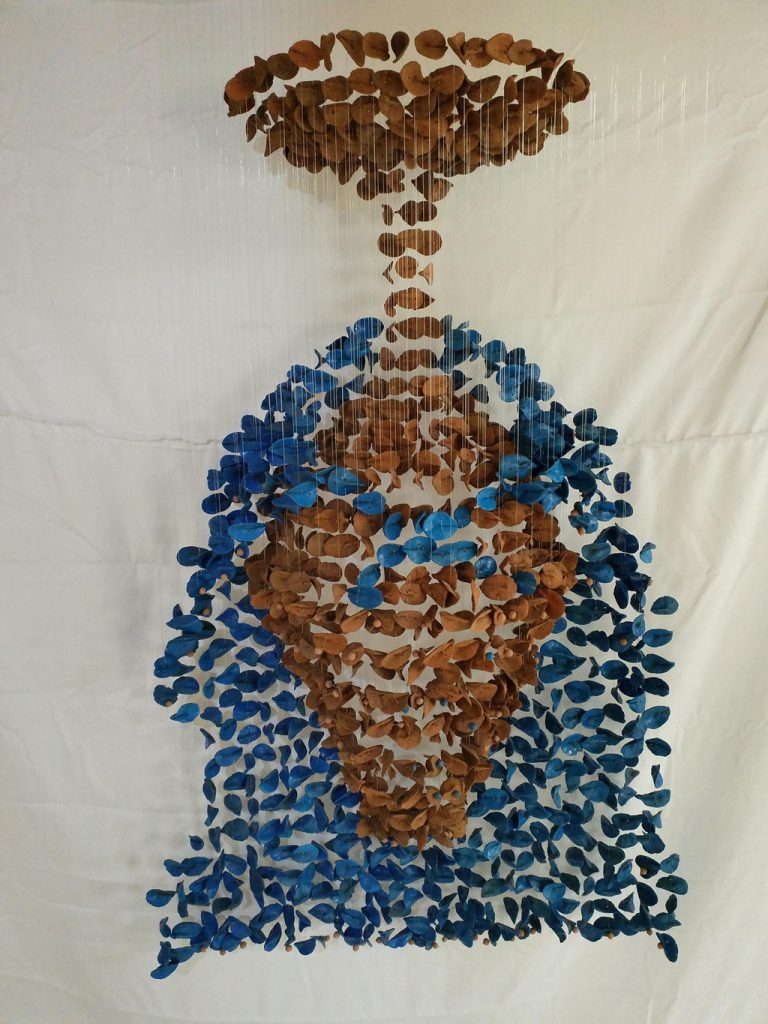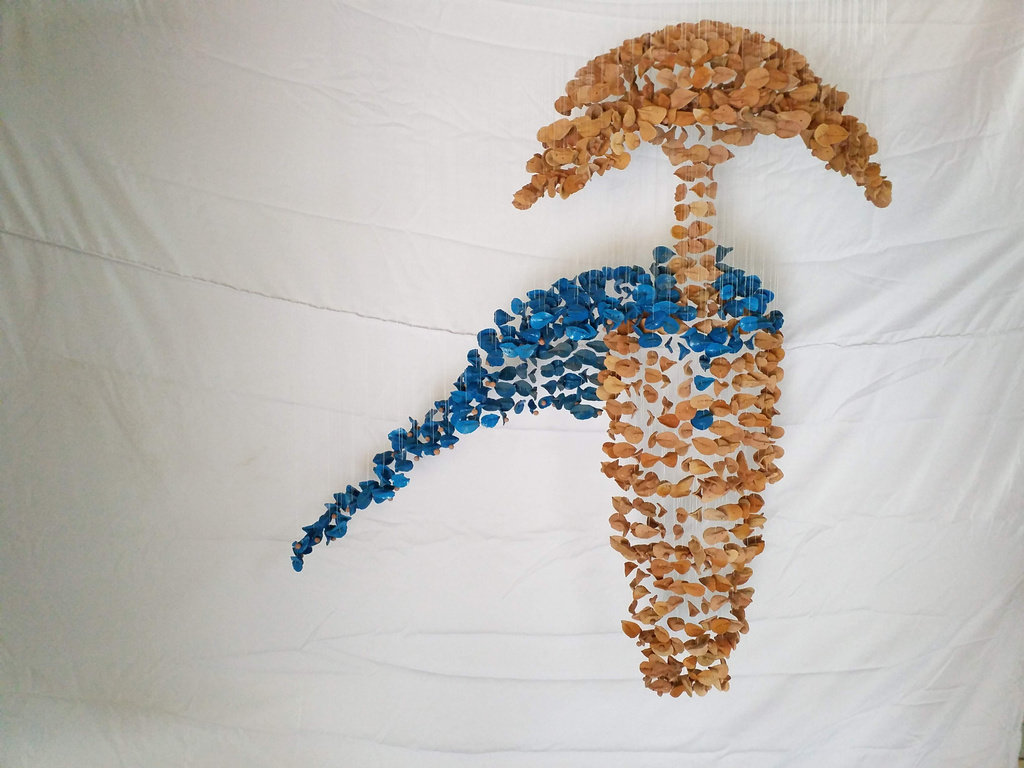Ngozi Omeje incarnates the matriarchal Igbo story of the circle of connections that make a community.
I trained as a ceramic artist at the Department of Fine and Applied Arts, University of Nigeria, Nsukka. In 2009, after completing my Master’s degree in ceramics, I was offered a teaching appointment at the Nsukka art department. Thus, the past decade has combined art teaching and studio practice.
My studio is located in the remote area of Nsukka, where I mostly have birds of various species during the day, crickets, and other night crawlers as companions. Two times, I have sighted a buzzard eagle. Toucan has been fighting with its reflection in the aluminium glass (mirror) windows on a daily basis, occasionally invading the creative thought flow or the serenity.
Hummingbirds, sparrows and other yellowish and brownish birds chirping around add to the magical feeling.
I am currently working on forms of vessels with light and dark hues to create patterns. Expanding their shapes and sizes, clothing them with designs derived from materials and textile fashion. In this direction, it’s a great way for me to personalise these vessels as humanoid. Symbolic representation of individual presentations or personalities with limitless borders. For quite a long time, I have been working with multiple units, and leaves have become dominant motifs. Interrogating seasons and experiences; for me (as well as many other women in my community), it becomes imperative to learn from the tree’s adaptation to the changing seasons.
These challenging experiences within this enclave led me, as an artist, to analyse a fable in the present context -the story of Nneburube. There are present-day similarities in women’s struggles.
The tale of Nneburube
Once upon a time, a long time ago, there was an iconic woman who lived far away, as narrated by the people of Ehalumona Community in Nsukka, named Nneburube. It was every girl’s dream to marry, and so Nneburube got married to Ezenwoha (the village king).
Ezenwoha was a prominent man in the land who gave many baskets of yam, the sacred farm crop of Igbo land, to his accolades. In the olden days, as well as presently, yam was considered sacred and very valuable in comparison to other farm crops. So, it was used as a tool to measure a man’s wealth and status in the community. And this tuberous crop he had in great numbers. Hence, he was able to acquire many wives, including Nneburube. Many of his wives bore children for him. However, Nneburube had the highest number of children. She gave birth to ten children.
Ezenwoha, as much as he was a wealthy man, was also shrewd in his dealings. Therefore, he would share one basket full of the yam tubers and the precious crops with his wives, regardless of the number of children. This ratio was difficult for most of the wives who had more children, but Nneburube’s difficulty, who had ten children, was exceptional.
Driven by hunger and motherhood, Nneburube stole another basket of yam tubers from Ezenwoha’s yam ban. Being a shrewd man, Ezenwoha was provoked to wrath, and he cursed the thief through the village’s shrine to kill and eradicate the thief’s children.
Witnessing this action and Ezenwoha’s intention, Nneburube was weakened and downtrodden. Her aims and efforts to care for her children have been defeated if they were all to perish because of the curse placed on her.
Overwhelmed and in thought, Nneburube was in her kitchen tinkering for a solution, and suddenly a lizard fell from her dryer in front of Nneburube. Infuriated, Nneburube tried to kill the lizard. Scared, the lizard pleaded for its life. Please don’t kill me, I will give you an orkro seed to plant. And if the orkro seed germinates, Nneburube will die, but her children will be saved. Also, if the orkro seed germinates and bears fruit, they will all survive.
And so, Nneburube planted the orkro seed. The seed germinated. She was very jubilant, at least her children were saved. While she was jubilating, another lizard nibbled on the tip of the germinated orkro plant. Nneburube said to the lizard, “Eat or do not eat, the curse placed on the stolen yam tubers has transferred to you.”
The lizard then positioned itself as a stone on the ground, a stumbling stone. A goat skidding away stumbled on the lizard. The lizard said to the goat, “Kick or do not kick me, I nipped Nneburube’s orkro plant and Nneburube stole a basket full of Ezenwoha’s yam tubers and Ezenwoha cursed the thief to death with the children in the village shrine.”
The goat ran home. On reaching home, the doe saw its owner bathing her baby. Then the goat sipped water from a bowl the woman was using to bathe her child. The woman beat the goat. Responding, the goat said, “Beat or do not beat me, I stumbled on a lizard, and the lizard nipped Nneburube’s orkro plant and Nneburube stole a basket full of Ezenwoha’s yam tubers and Ezenwoha cursed the thief to death with the children in the village shrine.”
Comprehending what had transpired, the woman turned her baby upside down and continued bathing her child. A palm wine tapper saw the woman doing so. Exclaiming, he said, “Whoa, what is happening?” To exonerate herself, replying, she said to the taper, “Whoa or do not whoa, I beat my goat and the goat stumbled on a lizard and the lizard nipped Nneburube’s orkro plant and Nneburube stole a basket full of Ezenwoha’s yam tubers and Ezenwoha cursed the thief to death with the children in the village shrine.”
Of course, the palm wine tapper did not want to absorb someone’s curse. So he too did something unusual. He started climbing the palm tree upside down with his legs. Some gatherers, plucking wild fruits, saw the wine taper. In awe, they said, “Look, the wine taper is climbing the tree with his legs.” In turn, the wine taper said, “Look at me or do not, I saw a woman bathing her baby upside down and the woman beat her goat and the goat stumbled on a lizard and the lizard nipped Nneburube’s orkro plant and Nneburube stole a basket full of Ezenwoha’s yam tubers and Ezenwoha cursed the thief to death with the children in the village shrine.”
Potters passing by, with stacks of terracotta pots balanced on their heads on their way to market, asked the gatherers what was happening.
Then the fruit gatherers climbed the tree. Instead of plucking fruits, they fell in succession. Resoundingly, they continued climbing and falling. Potters passing by, with stacks of terracotta pots balanced on their heads on their way to market, asked the gatherers what was happening. The gatherers responded, “Ask or do not ask, we saw the wine taper climbing palm tree with his legs and the wine taper saw a woman bathing her baby upside down and the woman beat her goat and the goat stumbled on a lizard and the lizard nipped Nneburube’s orkro plant and Nneburube stole a basket full of Ezenwoha’s yam tubers and Ezenwoha cursed the thief death with the children in the village shrine.”
In turn, the potters started smashing their pots. Labourers (hired farmers) tilling and cultivating yam crops in Ezenwoha’s farmland saw the potters smashing their products. Surprised, they pointed, see! The potters are breaking their pots. The potters smashing their pots said to the farmers, “See or do not see us. We enquired from the fruit gatherers who fell from a tree, and the gatherers saw the wine tapper climbing a palm tree with his legs. The wine tapper saw a woman bathing her baby upside down, and the woman beat her goat. The goat stumbled on a lizard, and the lizard nipped Nneburube’s orkro plant, and Nneburube stole a basket full of Ezenwoha’s yam tubers, and Ezenwoha cursed the thief to death with the children in the village shrine.
In like manner, the farmers shredded the tubers of yam into pieces. Ezenwoha came to survey the labourers’ progress. On seeing what was happening, I requested an explanation. The farmers responded, “Request or do not request, we saw potters smashing their pots and the potters enquired from fruit gatherers falling down from a tree and the gatherers saw a wine tapper climbing palm tree with his legs and the wine tapper saw a woman bathing her baby upside down and the woman beat her goat and the goat stumbled on a lizard and the lizard nipped Nneburube’s orkro plant and Nneburube stole a basket full of Ezenwoha’s yam tubers and Ezenwoha cursed the thief death with the children in the village shrine.”
Like a boomerang, Ezenwoha realised that the same curse he pronounced to affect the thief had revolved back to him. So he annulled the curse.
- Ngozi-Omeje, New Arrival, 2024, ceramic/ plastics/ metal, 150 x 120 x 30cm
Inspired by the story of Nneburube, I created three artworks capturing different stages in a woman’s life in my community. New Arrival, Big Heart and Overflowing. New Arrival is the first stage, when a woman is newly married. Expectations meet reality. Big Heart captures an increase as the woman starts bearing children and responsibilities. Overflowing discusses dual responsibilities in a never-ending circle. Symbolically, the cape around the vases carries the weight of the meaning behind the artworks. The positions at different levels revealed the emotional state of the vessel.
Comprehensively, from these interrogations, it can be deduced that the cyclical nature of shifting responsibilities to children, which has evolved into child labour, is a coping mechanism for these women. A coping approach that is being exploited both intentionally and unintentionally daily. These women, though trying to avoid the fate of Nneburube by not stealing, have invariably created another menace in society. However, neglecting the root, which is the womanhood and their struggles, sets forth negative energies that revolve around us.
About Ngozi Omeja
 Ngozi Omeje Ezema is a Nigerian ceramic artist renowned for her innovative sculptural installations. Working primarily with clay and terracotta, she creates large-scale, often suspended works that explore themes such as identity, memory, and the complexities of human relationships, frequently drawing on her personal experiences and cultural background. Based in Nsukka, she both studied and now teaches at the University of Nigeria, where she has contributed to the growth of contemporary ceramic art. Her practice is celebrated for pushing the boundaries of traditional ceramics, transforming everyday materials into evocative, conceptual artworks that engage with both local and global art discourses. Visit ko-artspace.com/artists/34-ngozi-omeje-ezema/, follow @ngozichukwukaomeje and like facebook.com/ngozi.omeje
Ngozi Omeje Ezema is a Nigerian ceramic artist renowned for her innovative sculptural installations. Working primarily with clay and terracotta, she creates large-scale, often suspended works that explore themes such as identity, memory, and the complexities of human relationships, frequently drawing on her personal experiences and cultural background. Based in Nsukka, she both studied and now teaches at the University of Nigeria, where she has contributed to the growth of contemporary ceramic art. Her practice is celebrated for pushing the boundaries of traditional ceramics, transforming everyday materials into evocative, conceptual artworks that engage with both local and global art discourses. Visit ko-artspace.com/artists/34-ngozi-omeje-ezema/, follow @ngozichukwukaomeje and like facebook.com/ngozi.omeje




